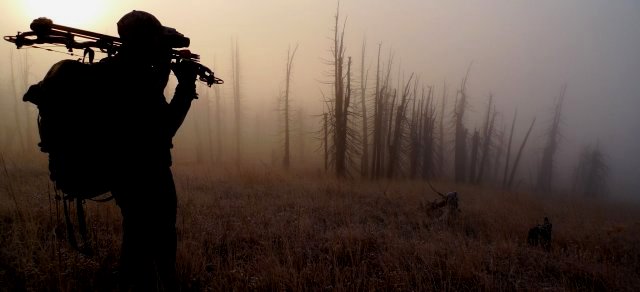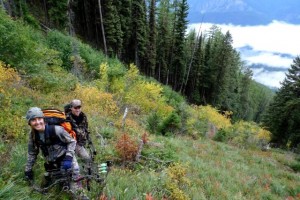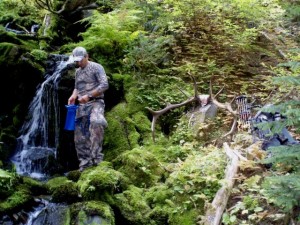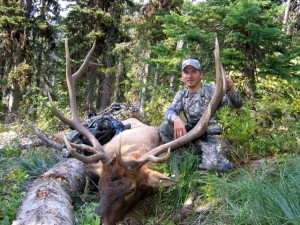Bivy Hunting for Elk

Bivouac: (bɪv.u.æk), (bɪv.wæk) – Noun
-An encampment for the night, usually without tents or covering, with few facilities, as used by soldiers, mountaineers, etc.
Bivouac style of hunting, or bivy hunting as it is popularly known, has been used for ages and has been called various different names throughout the years of modern sport hunting. Spiking-out, coyote-out, and roughing it under the stars are some descriptions that come to mind. No matter what it is called, it has become very popular in recent years. A quick search on various hunting forums will reveal just how popular this style of hunting has become.
 It used to be a very small segment of the hunting population that would bivy in the backcountry. As the front country has become more crowded and competition more fierce for a limited resource, however, more hunters are turning to backpack outings for their annual elk hunts. Once in the backcountry, hunters are finding less competition and more quality of an experience along with a more rewarding hunt.
It used to be a very small segment of the hunting population that would bivy in the backcountry. As the front country has become more crowded and competition more fierce for a limited resource, however, more hunters are turning to backpack outings for their annual elk hunts. Once in the backcountry, hunters are finding less competition and more quality of an experience along with a more rewarding hunt.
In order to have a fun and successful bivouac hunt there are a few things to consider before you take off and as you hunt. The first thing you need to think about before you tackle a backpack style hunt is your physical fitness. If you’ve never back packed recreationally before, get out and try it. You may find that it’s not as fun as expected or that you need to get in better shape. This is also a good time to try out new gear and to learn what you need and don’t need in the backcountry. Beginners tend to over pack and a few preseason trips will educate more than any forum can.
When you plan your hunt, keep in mind a few logistics before you head out. Think about water sources, potential elk locations, and where you might spend the night. Most of the time I carry camp on my back until I hear elk nearby or run into fresh sign. I will hunt that area first thing in the morning while I leave camp set up. If the area doesn’t produce or I blow the elk out of the basin, I pick up my gear and move on. If I am into elk, I leave my camp set up. At the same time I am ready to cover ground with everything on my back until I find that fresh sign.
 Sometimes I have to move my sleeping spot to an area that is less intrusive to elk. A mistake that many hunters make is sleeping too close to the elk. An errant breeze in the night can alert the herd to your presence and push them out of the area. Also, love sick bulls tend to wander and may stumble upon your sleeping area and alert the rest of the herd. The bottom line is to sleep close enough to minimize the time to get on the elk in the morning, but not so close that you spook them into the next county.
Sometimes I have to move my sleeping spot to an area that is less intrusive to elk. A mistake that many hunters make is sleeping too close to the elk. An errant breeze in the night can alert the herd to your presence and push them out of the area. Also, love sick bulls tend to wander and may stumble upon your sleeping area and alert the rest of the herd. The bottom line is to sleep close enough to minimize the time to get on the elk in the morning, but not so close that you spook them into the next county.
One problem I’m constantly dealing with where I hunt is water sources. They seem to be rare on the ridge tops and I don’t hunt near lakes or creeks so my water sources are usually springs and seeps mid-slope, which most of the time are close to the elk I’ve located. Again, be careful not to spook your elk when you resupply. Also, over the years I’ve learned to top off my water supply whenever the opportunity arises. There have been countless times I have dogged a bull out of a wet basin and onto a high and dry ridge top only. Then after a day of cat and mouse I have to retreat back into the basin for water. Now I always take a few minutes to top off my water supply no matter what. Going without enough water is not fun.
 Bivy hunting isn’t for everyone or every elk hunt for that matter. You need to be flexible and prepared for the unexpected. Finding and killing an elk can come at any time. Sometimes it’s the first day, sometimes it’s the 10th. And when it happens, the reward and satisfaction are worth the effort.
Bivy hunting isn’t for everyone or every elk hunt for that matter. You need to be flexible and prepared for the unexpected. Finding and killing an elk can come at any time. Sometimes it’s the first day, sometimes it’s the 10th. And when it happens, the reward and satisfaction are worth the effort.
